Introduction
Participating in the Race Around The Netherlands has been my dream for years, yet amidst the business of life, committing to the required training was not possible. However, an unexpected career change created a unique opportunity by freeing up my calendar and providing me with enough leisure time to pursue this long-cherished dream. Being nowhere near the required fitness level to participate in the 2024 event, we came up with an alternative plan – to utilise the RATN route for training purposes.
Preparing the route
I downloaded the official route stages from the website, stuck it all together into one big route and then cut it up in roughly 200km sections. After doing that, I scoured the map for waypoints that seemed relevant to me. There’s a cool YouTube tutorial where I learned most of my planning skills.
Ride with GPS
The things I marked are:
- S = Supermarket
- E = Food (Dutch: eten). These are things like bakeries and snackbars, where you can walk in and out with prepared food. I decided against marking restaurants because it just takes a lot of time to eat there and there’s so many around that a quick look on Google Maps would be sufficient.
- A = Pharmacy (Dutch: apotheek). I figured it would be good to mark these in case we needed some first-aid supplies
- $ = ATM
- C = city center, in case we were looking for something specific or a place to eat
- T = train station. I wanted to mark these because they have sanitary facilities available 24/7 and if we decided to “scratch” we could simply hop on a train home
In order to not be overwhelmed by waypoints on my eTrex during the ride, I put a waypoint before the town listing all facilities available. So For example: SEACT Vlissingen means in Vlissingen there is a supermarket, a place to eat quickly, a pharmacy, a city center and a train station.
Here you can see how the prepped route looks like
Stage cards
To have an easy and quick overview I printed out small cards of the stage at hand. I made these in Excel. I kept these small cards in my frame bag for some quick planning along the route. This is an example of stage 5:
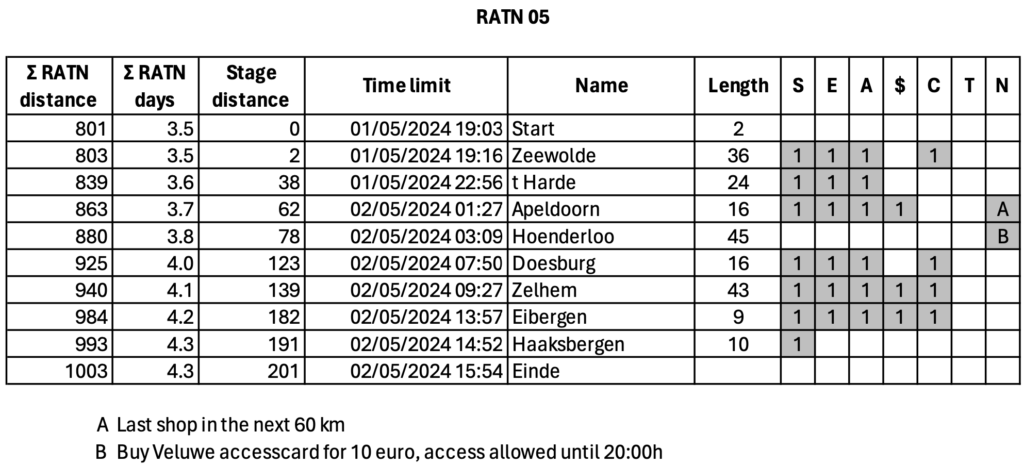
Legend
- Σ RATN distance = the total amount of kilometers done
- Σ RATN days = the total duration of the ride in days
- Stage distance = the amount of kilometers completed in stage 5
- Time limit = the date and time we have to leave a certain time-point to make the cut-off of 202 hours
- Name = the name of the town we pass
- Length = the distance until the next town
- S, E, A, $, C, T are explained above
- N = specific notes and hints during the route
Packlist

My bicycle is a Specialized Diverge Comp E5 from 2020. The Tailfin carried the things I would need regular access to such as my rain jacket, a warm long sleeve fleece, a down jacket and some bicycle maintenance stuff. The frame bag is a BBB Middle Mate, here I put the things I would use a lot such as some warm gloves, the little stage cards I made, chamois cream, wet wipes and also my powerbank and iPhone lived there. In the frame I put my two water bottles, a Fidlock 590 mL and a Fidlock 450mL bottle. All my food (mostly Haribo and dextrose tablets) were stored in the Evoc Top Tube bag.
The cockpit
My navigation unit is the Garmin eTrex 35 Touch, made with custom maps by yours truly. I use Rose Attack Aerobars to which I strapped a Restrap Aero bar Bag. In it were the things I needed to spend the night in a hotel, such as clothing, a fresh pair of bibs and toiletries. After long deliberation I opted for the Restrap bag instead of the Cyclite Aerobar Bag (which was kindly gifted by my parents; thanks again mom & dad!) because it had a bit more packing volume and was easier to take off the bike and into the hotel room. I hate faffing around with bags with a passion. The lamp is a Ravemen PR 2000.
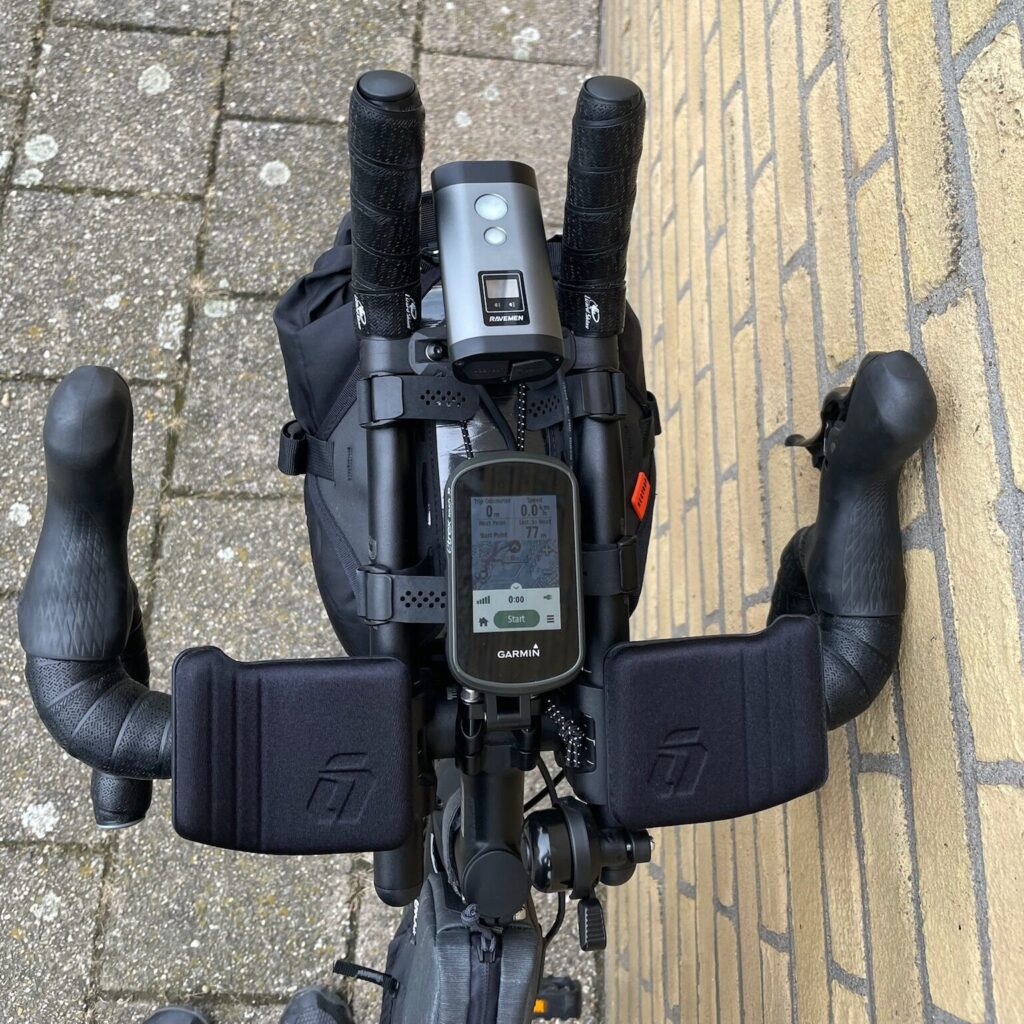
Travel journal
Day 1
In order not to interfere with the official race, we opted to start our training round near Hoek van Holland, one day after the official race had begun.
The first day of our training route led us past Rotterdam along the river toward the sea.

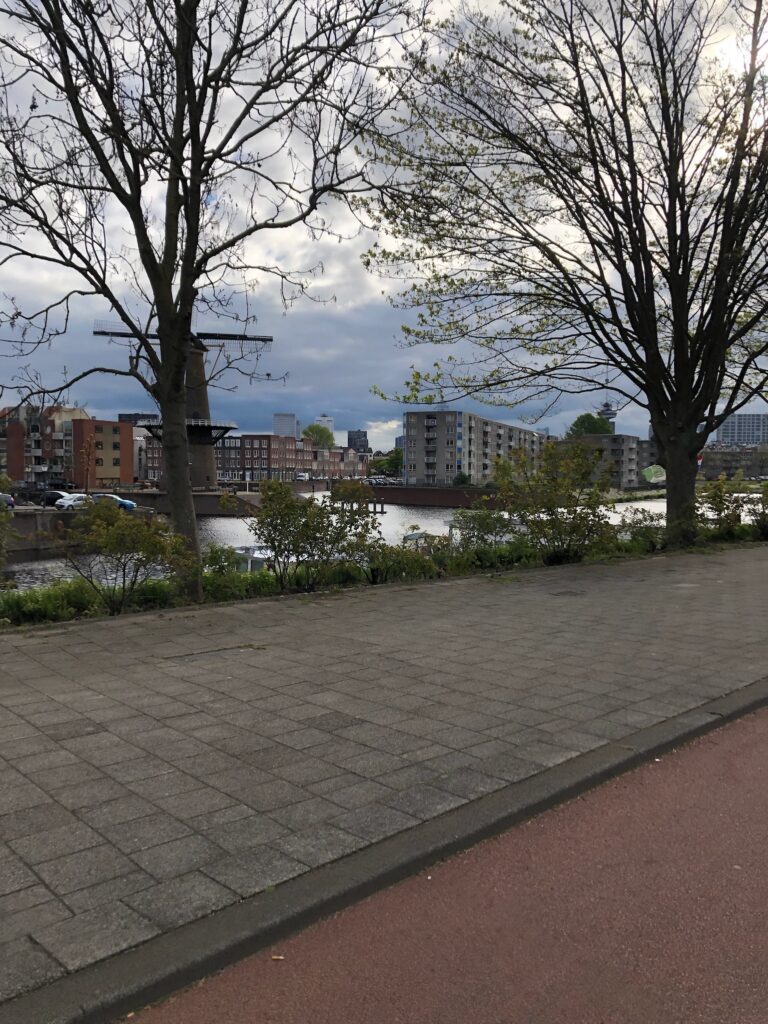
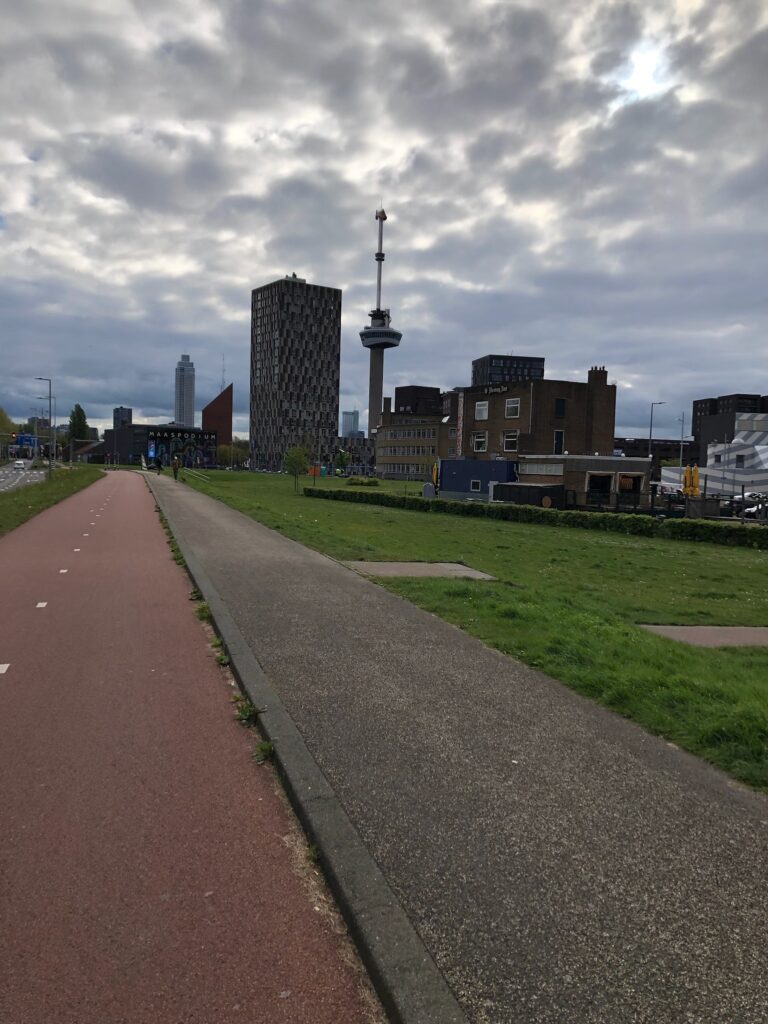
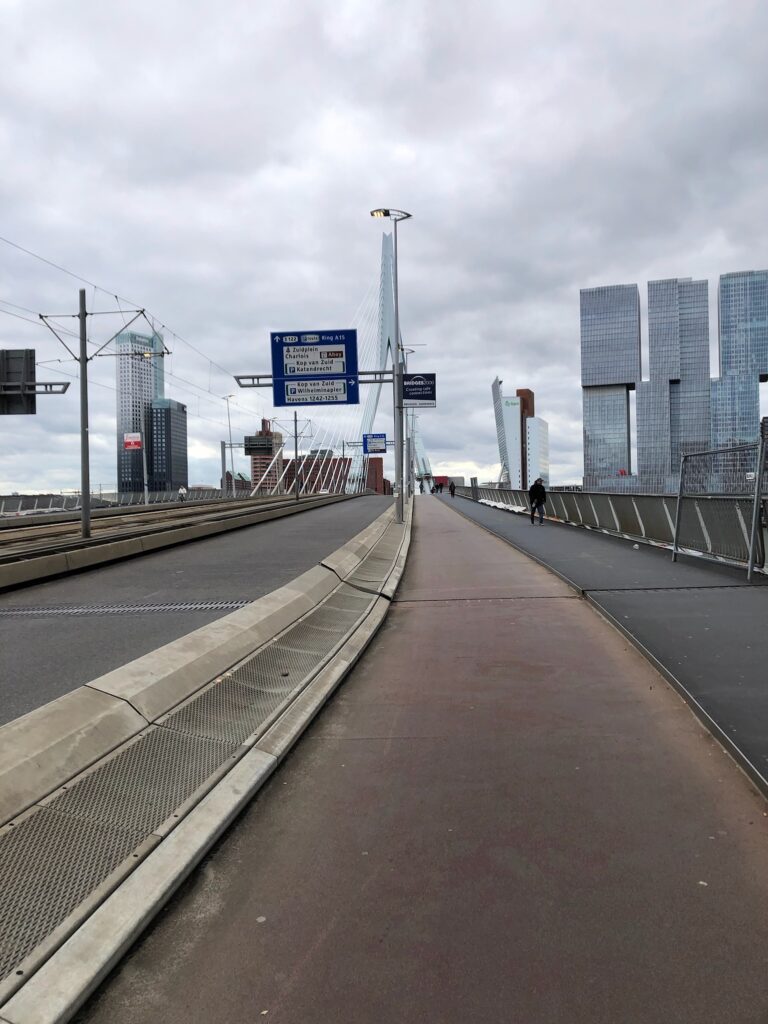
As we cycled past Rotterdam we entered a nature reserve. We were greeted by several sheep with small lambs that were playing together. One sheep decided the cycle path was an excellent spot to take a nap, and wasn’t bothered in the least we had to pass by it quite closely. The first 100 km went without any problem, and took us 5 hours.



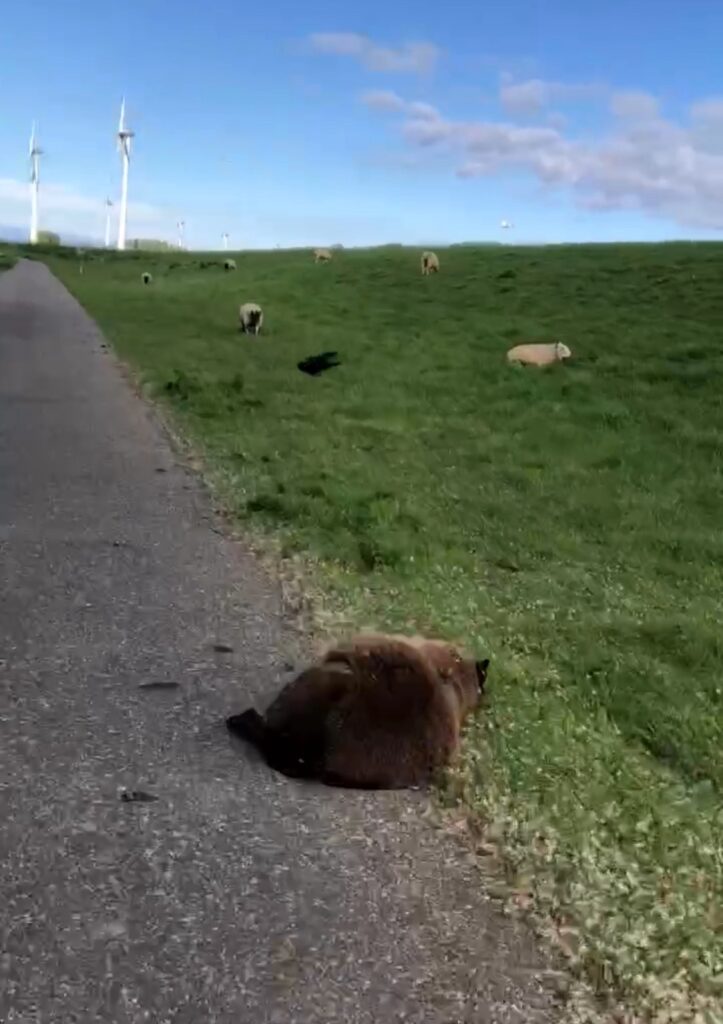
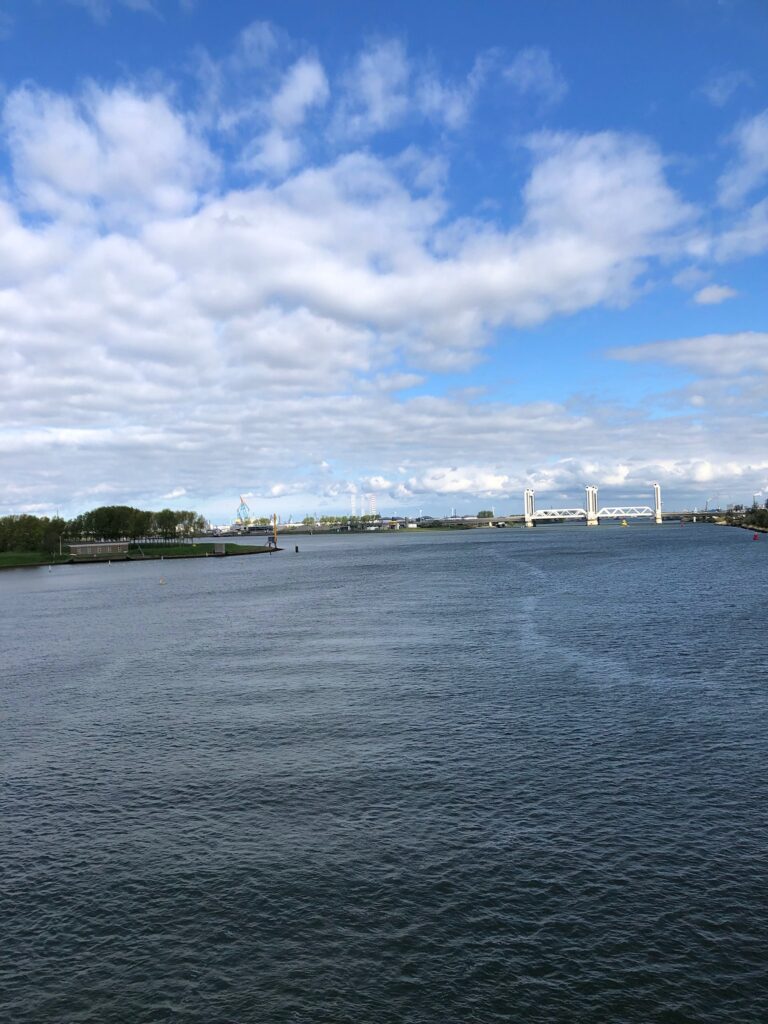

I felt optimistic, energised, and since I wasn’t tired at all, I thought 200 to 250 km (125 – 155 miles) would be an achievable distance. Little did I know, the problems were about to start…
After following the route southward from Rockanje, the headwind started. The first bridge we crossed, the Haringvlietdam, had such strong winds they pushed me off the road. It’s not that clearly visible on the pictures, but the headwind at Brouwersdam was blowing up a lot of sand. I remember hearing my entire drivetrain screech because it was marinated in sand. At that point, I was very glad I was wearing cycling glasses.


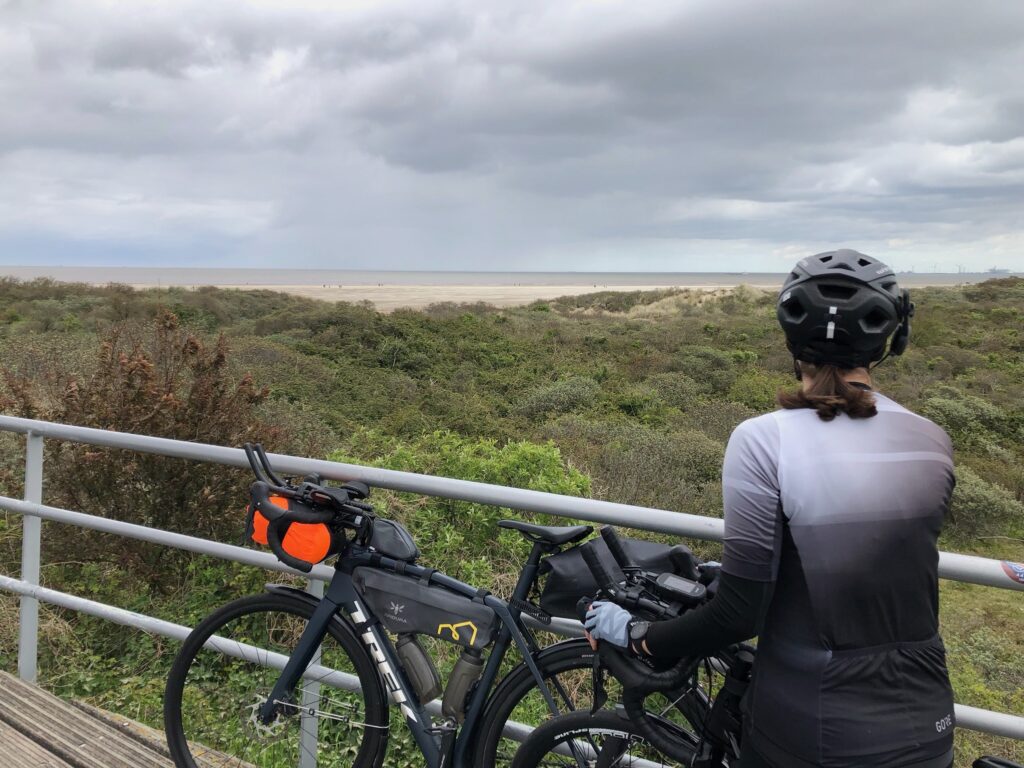
After crossing the Haringvlietdam and the Brouwersdam we were cycling for 6.5 hours without a break. I was starving, so we decided to take a rest in Burgh-Haamstede. We rode into town and parked our bicycles at the Graaf of Haamstede restaurant, only to find out we forgot to bring the key of our lock, effectively rendering it useless dead weight. Luckily only a couple of meters down the road we were able to buy a new lock at the HEMA. At the restaurant we ordered their famous burger, it was really good and being totally starved I managed to finish the entire thing.
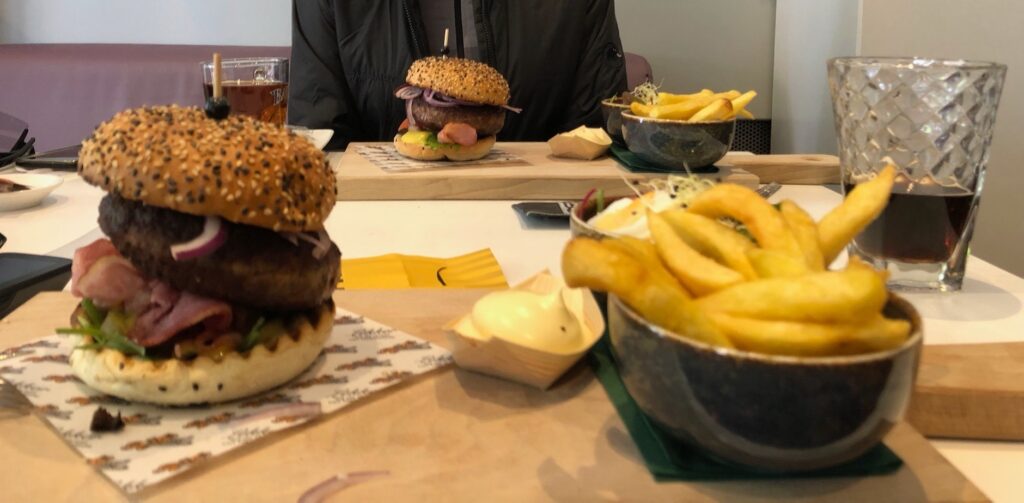
Our total time off the bike was 1 hour. After stopping at the Albert Heijn on the Burghseweg to resupply, we continued our journey southward. As we cycled out of Haamstede, I remember thinking “it’s cold and there’s such a strong wind, how much worse can it possibly get?” Boy did I regret that thought, not one minute after thinking that it started raining.
In total, we did roughly 100 km (± 80 miles) with a headwind of up to 75 kmh (± 46 mph). At Neeltje Jans the wind pushed me off the road for the second time. The headwind came in strong waves, was laced with sand, and in combination with rain made the crossing of the bridge very challenging. It was so strong the water drops were blown off my cycling glasses sideways. It wasn’t possible to change hand positions nor to use the aerobars becuase it was very hard to keep my bicycle straight, forcing me to sit fairly cramped in the same position for hours on end. Most of the time my speed was between 8 – 10 kph (5 – 6 mph). Drafting was out of the question as it was too dangerous. Because of the slow speeds I had more contact time with my saddle and after crossing the bridges I felt the first hint of a saddle sore forming.
After a while the route changed direction to south-east, and the headwinds became side-winds after we passed Westkapelle, making them a bit easier to deal with. The rain stopped, and we were treated with a couple of stunning views of the Dutch coast.
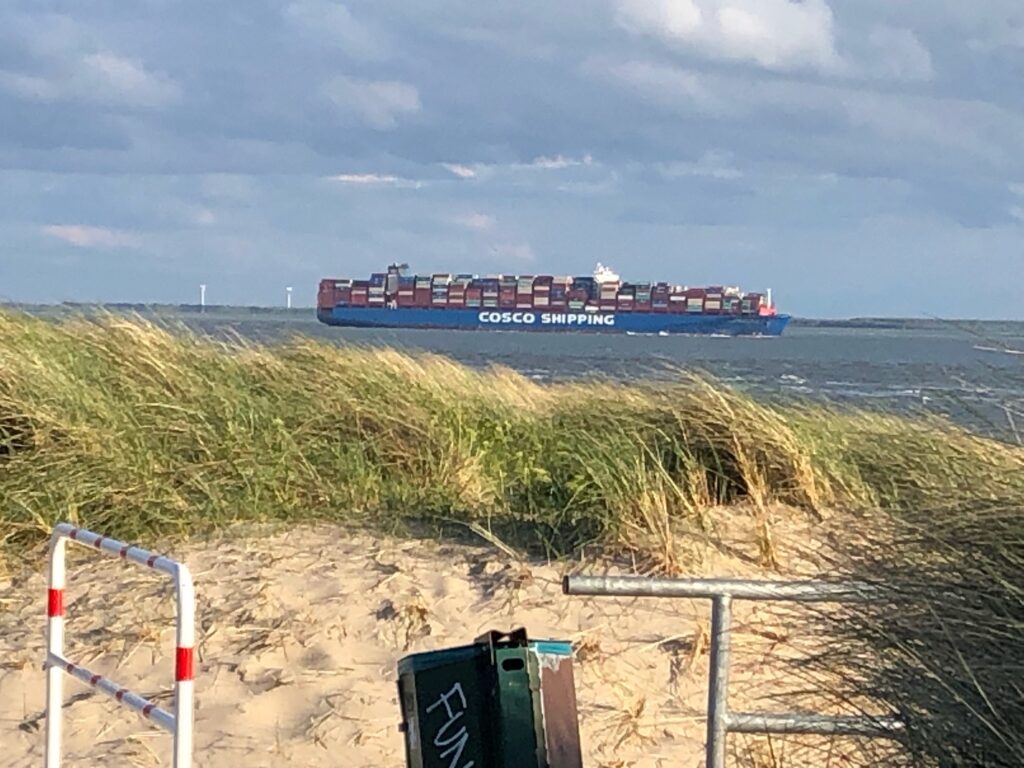

After arriving at Vlissingen we were tired, and seeing it was past 19:00 hours we decided to look for a hotel to spend the night.

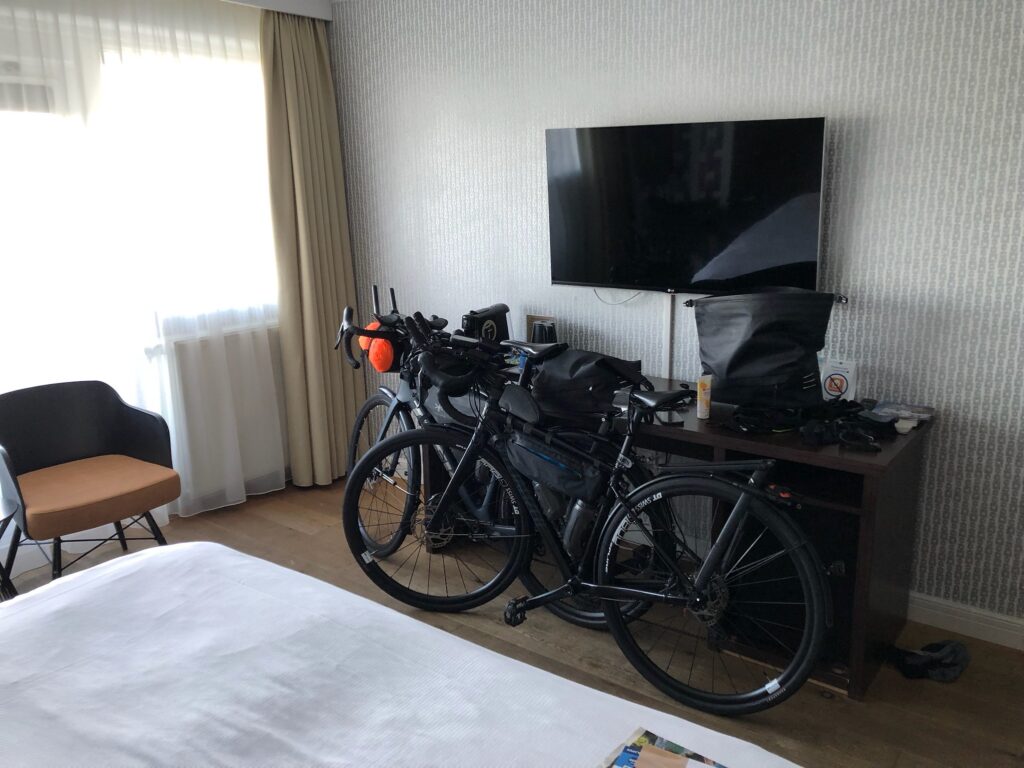
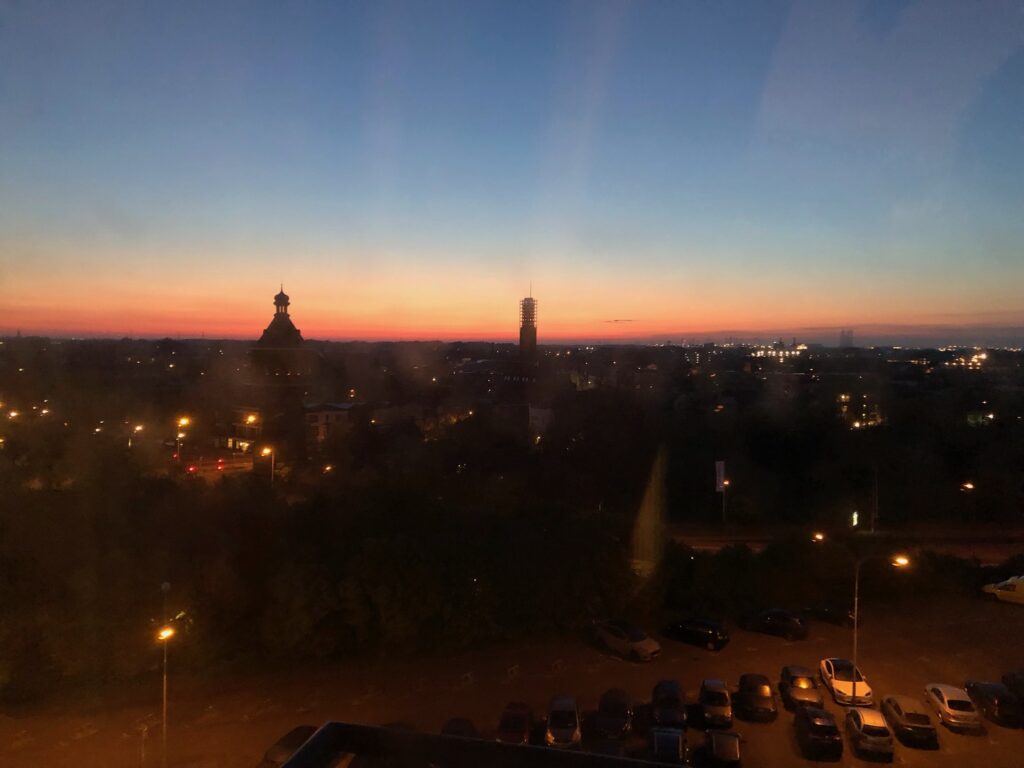
We stayed at the Fletcher Hotel, the room was wonderful and we were allowed to bring the bicycles into the room, saving us a lot of time and faffing around with bags.
The recap
The stats
- Total distance: 168 km (105 miles).
- Total time elapsed: 11 hours and 25 minutes.
- Moving time: 9 hours and 46 minutes.
- Stopped time: 1 hour and 40 minutes (1 hour in restaurant, couple of sanitary pitstops and resupply at supermarket)
- Average moving speed: 17.2 km/h (= 10.7 mph)
- Calories burned: 3600
Day 2
Waking up on the second day was… challenging. I was stiff and sore from fighting the headwind the day before, and for some reason unbeknownst to me I woke up with nausea. I managed to drag myself out of bed and head towards the breakfast room, which the staff kindly opened one hour early for us. I somehow successfully forced down two buns with chocoladevlokken and some English breakfast tea. We quickly packed our stuff together and headed out the door. The ride out of Vlissingen was absolutely stunning.

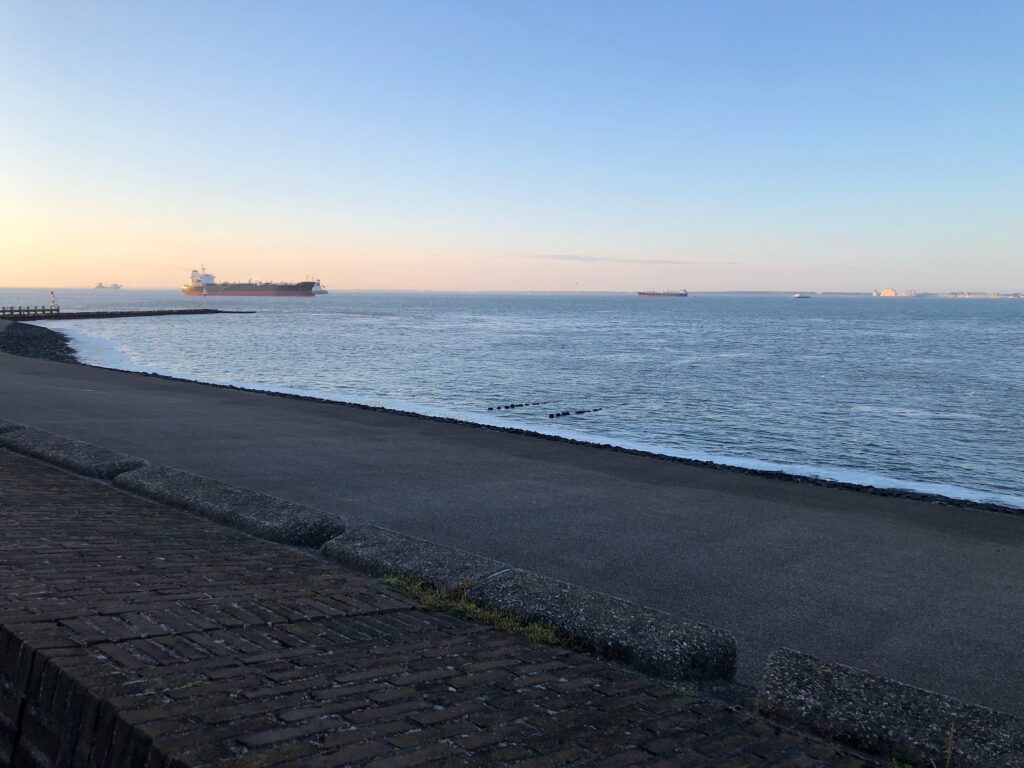
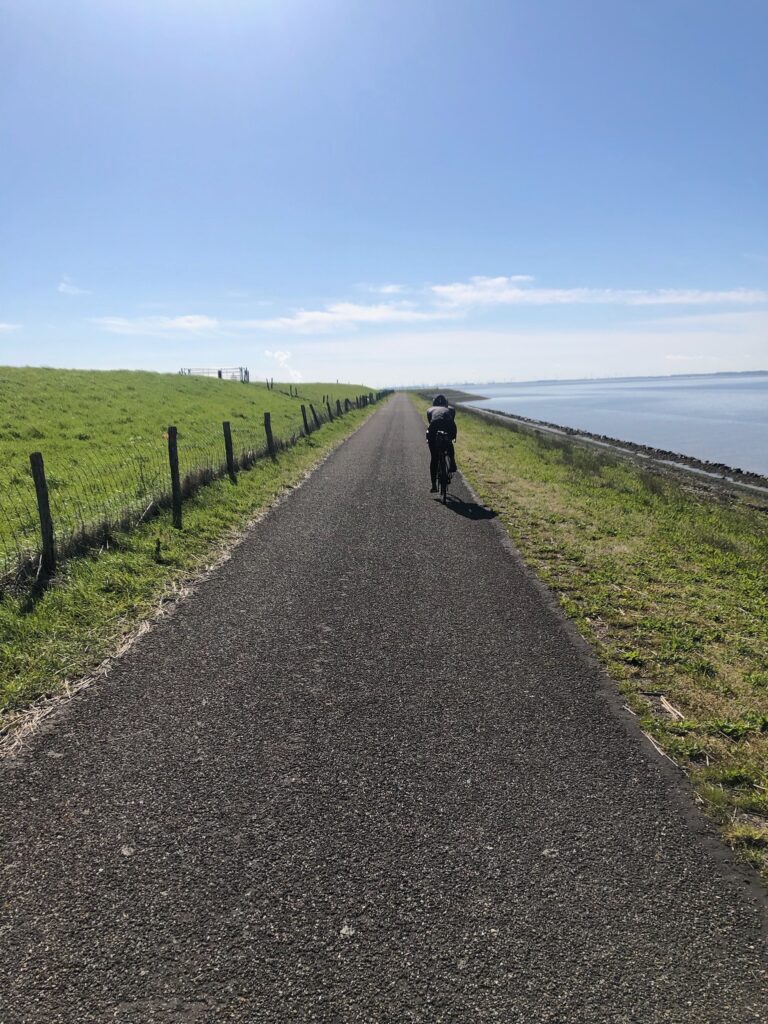
There was a wonderful sunrise, there was no wind anymore and after cycling for a couple of kilometers the soreness and nausea were mostly gone. We ran into a little navigational challenges at the docks of Vlissingen, one bridge was open so we had to take a little detour.
After 35 kilometers, we made our first stop at Goes, where we restocked with krentenbollen and water from the Albert Heijn. I took a moment to use the facilities at Bakker Bart, but was disappointed to find that I had to pay for the toilet and there was no hand soap available. The bathroom was also very unclean. I was relieved to get back on my bike and continue on to our next stop 15 kilometer later at Kruiningen’s COOP supermarket.
After 85 kilometer we were in Huijbergen where we decided to take a lunchbreak at Slagerij Wisse. I was very happy to have some decent food, since I didn’t have a proper breakfast and I was starting to get fed up with my Haribo & krentenbollen diet. They had a ton of healthy and good food, I had potato salad with a sandwich bacon/cheese sandwich, Marco had two sandwiches, one with roasted meat and the other with meatloaf. We made the next stop at the Albert Heijn in Zundert (120 km into the ride) where we ate some dutch apple pie and afterwards another stop at Bakkerij de Gils in Chaam (140 km).
At that point I was starting to get a bit frustrated because we were not making the progress I had hoped for. The many pitstops were staring to annoy me a little, but the saddle sore didn’t leave me with a lot of other options.
After cycling into Hilvarenbeek (170 km) it became clear we would not be able to make it to Weert, which was our goal for that day. It was a hard decision to make, but we decided to let go of the time limits and to take a rest day. After looking on booking.com, we saw a B&B a couple of meters off the route and checked in.
The B&B was called B&B Klein Beek, the owner decided to put us in th honeymoon room and it was absolutely stunning. During the tour of the B&B, he told us about the history of the building. After World War II, the farmhouse was broken and no longer habitable. An emergency building had then been erected on the property by the owners. The farm was repaired and the emergency building was converted into a B&B. The owner grew up in the building; from the love and time he put into creating the various rooms, it was clear to see that running a B&B was his passion.
The recap
The stats
- Total distance: 165 km (104 miles).
- Total time elapsed: 10 hours and 59 minutes.
- Moving time: 8 hours and 16 minutes.
- Stopped time: 2 hour and 43 minutes
- Average moving speed: 20 km/h (12.4 mph)
- Calories burned: 3120
Day 3
Cap 138 cycled past us as we were sleeping (around 01:55 in the morning). He was then the first in the race and was followed by cap 1 which passed us around 04:33 in the morning. During the day we went to the center of Tilburg and later met up with friends to have dinner at Herberg den Hemel.
The B&B was excellent, the owner himself made breakfast for us every day with fresh cut fruit and fresh bread from the oven.
Even though we had cycled 170 km (105 miles) for two consecutive days, I was somewhat disappointed in my own performance. It was not so much a matter of stamina, but my saddle sore prevented me from cycling further than that. At that point I began to realize the price of the storm on the first day. Because of the strong headwind, I probably had more saddle contact than usual. We bought some skin restorative cream at the pharmacy and I hoped for the best.
Day 4
With my bum somewhat reanimated, we decided to give it another go. We got up at 05:15 hours and after another absolutely excellent breakfast were on our bikes at 07:00 hours.
The bike ride took us through the Leendert forest, the view was absolutely breathtaking. I recognised a lot from our previous bike tour in 09/2023, when we cycled from the Netherlands to Switzerland.

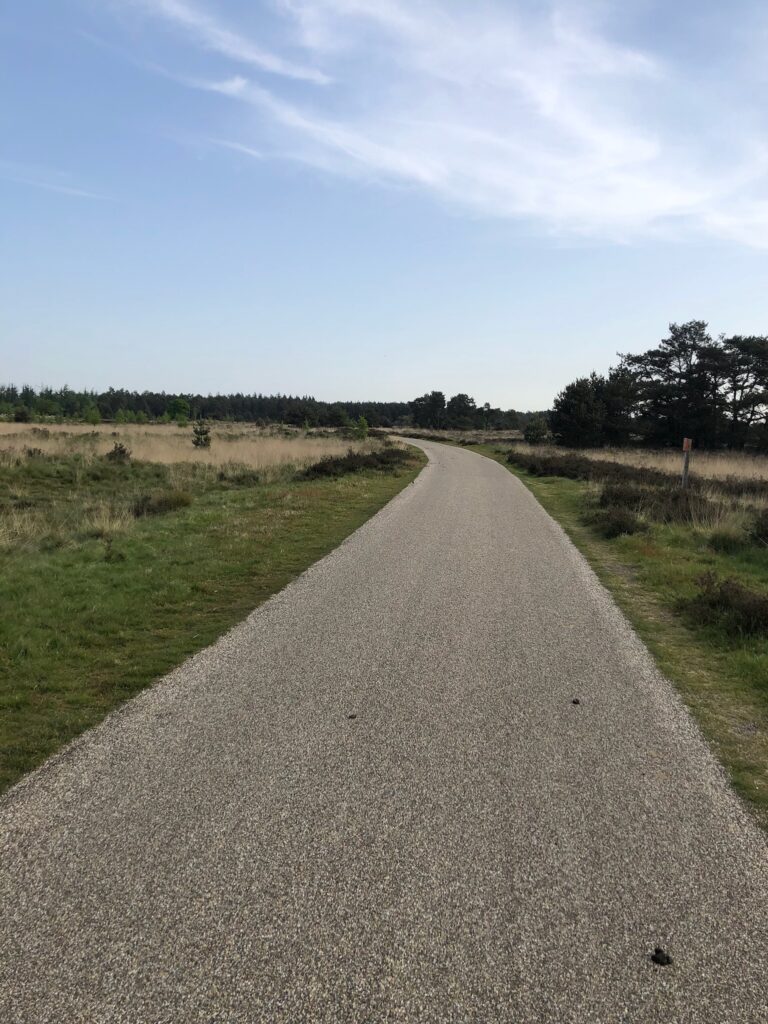
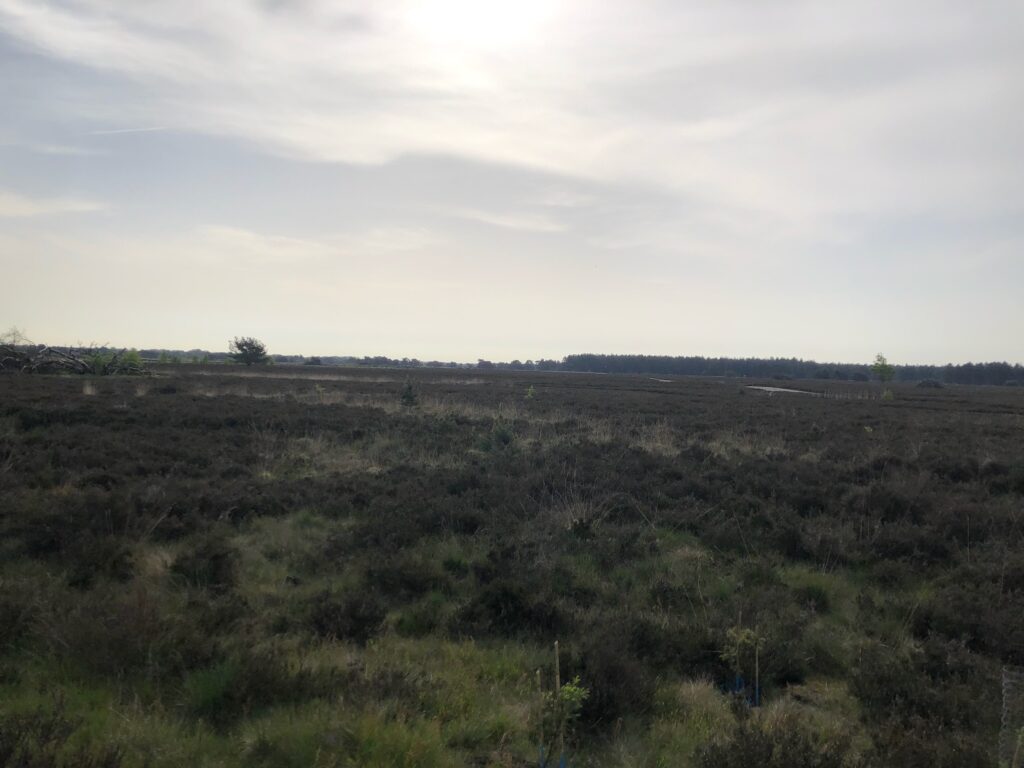
We made a quick resupply stop at the Lidl in Weert, we bought some krentenbollen and some water. They were kind enough to let me use their sanitary facilities.
While preparing the route, I had come across a pancake house in Thorn. It was just before lunchtime and we were both hungry, unfortunately the terrace and restaurant were completely full! Waiting would take a bit too much time so reluctantly we decided to cycle on and look for a nice alternative to have lunch.

Near Maasbracht the hunger became so bad that we decided to stop. We took a small tour of the city center and finally found a terrace by the water. After sitting there for a very, very, very long time and not being able to order anything, we reluctantly decided to move on again. We unfortunately lost a lot of time here.
Around Berg aan de Maas we met cap 196 and chatted for a few minutes. He looked fresh and said his legs were still doing well. After a quick chat and some encouragement from the both of us, he cycled off into the distance. The RATN has very strict rules when it comes to receiving support. Any form of outside support (for example, accepting a bicycle tire or food) is prohibited and leads to disqualification. Participants may only use facilities that are open to all participants, such as supermarkets, hotels and bike stores. Drafting is also prohibited unless you register as a pair and draft with each other. Encouragement is allowed of course!
Having long exceeded the terms of what is acceptable in regards to fasting, we finally found an Albert Heijn at Stein. I was so hungry I was pale and sweaty. Trembling with hunger, I walked in and bought sandwiches and all kinds of toppings. I was so low on sugar that the lady at the self-checkout had to help me with the registry, and to top it off, I forgot to take money with me to pay for everything. Luckily Marco wasn’t far away and was able to give me the debit card. We cycled to the first possible bench, fortunately it wasn’t far. I ate a ton and fortunately the shaking stopped after a while and I became a little clearer in my head.
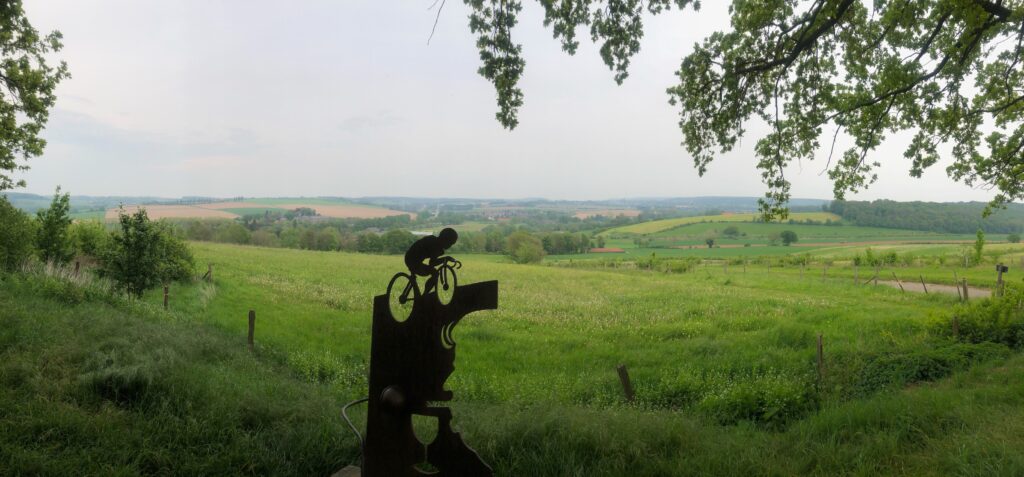
As we continued on our ride, we stopped at Valkenburg to revisit a favorite snackbar from our previous cycling tour. It was almost three-quarters of a year since our last visit, but the friendly lady behind the counter still remembered us! I asked her if it was a good or bad memory, and she burst out laughing before responding that it was indeed a good one. It was lovely to relive happy memories and enjoy another delicious milkshake!
After Schin op Geul, we followed the route toward the Keutenberg. When we were at the foot of the climb, I saw that the climb was 22%! Marco made it in one go without having to dismount from his bike, unfortunately at the end it got a little too hard for me and I walked the last part.
We made our stop for the day at hotel “La Source” in Epen. The bicycle shed unfortunately was full so we had to park our bikes outside in the garden, meaning a ton of faffing around with bags. We had some fastfood at the nearby snackbar, rinsed out our bibs and bunkered down for the night.
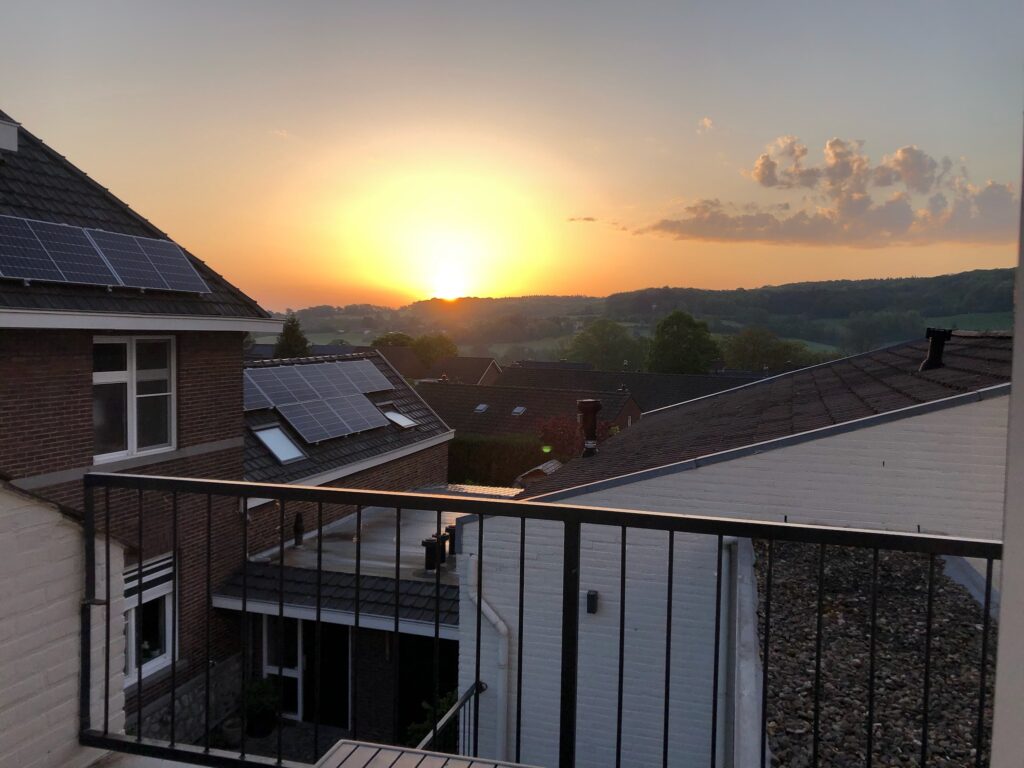
The recap
The stats
- Total distance: 169 km (105 miles).
- Total time elapsed: 11 hours and 20 minutes.
- Moving time: 8 hours and 53 minutes.
- Stopped time: 2 hour and 27 minutes
- Average moving speed: 19 km/h (11.8 mph)
- Calories burned: 3450
Day 5
As expected we lost some time in the morning because we had to put all of our bags on our bikes again. In the hall of the restaurant I stumbled upon the bicycle of cap 255, unfortunately I did not meet him.
After cycling to the Drielandenpunt most of the climbing was over. The Drielandenpunt is the border between The Netherlands, Germany and Belgium.
We did the first resupply stop at the Jumbo in Heerlen. I bought some sandwiches and toppings and we sat down on a nearby bench to eat. After a while some curious pigeons flew over, and because they looked quite hungry I fed them some bread. Shortly afterwards a gentleman walked up to us and warned us that there was a fine of 170 euros for feeding pigeons in Heerlen. This is because there are too many and the city wants to curb the population. He told us that the city had put up pigeon food containing pigeon birth control to prevent offspring. Of all the ways to control a pigeon population, birth control had never occurred to me. The Jumbo in Heerlen was the first and only place during our trip where I was not allowed to use the sanitary facilities.
I’m afraid the rest of the trip was quite uneventful (read: boring). In Susteren we stopped at the COOP to get some water and ice cream. It was quite warm that day so having something cool was awesome!
At Boukoul it became clear to us that it would not be possible to cycle the entire RATN route. My saddle sore, even though I took care of it several times a day, did not get better and even got worse every day. We came across a nice bench and decided to take a break. After some time, cap 49 showed up asking if we were participating. He had built a very ingenious installation on his bicycle; he used a 3D printer to make a box in which he had a power bank, which he charged with his bicycle dynamo. He could also use the electricity to power his lights. After a short chat he cycled on.

We decided to stop in Reuven after cycling only 115 kilometers (71 miles). Reuven would be the last stop on the route with a supermarket and facilities until Teuvel, which is about 80 kilometers away. Cycling a total of 200 kilometers that day was not possible due to my saddle sore.
The center of Reuven is very cozy, and in no time we had a nice seat on a terrace at Brasserie Effe where we enjoyed a delicious lunch. While we were sitting there we saw the first pair cycling past, cap 1029. They looked very energetic, were drafting each other perfectly and were cycling very fast. I was a bit worried about how they would fare with the impending storm approaching. Would they perhaps leave the route and take shelter in Venlo? Or would they try to cycle through the storm, even though the route passes through a nature reserve?
A quick look on the internet and we were able to book a room at Het Blauwe Huis. Just after we put our bicycles in the garden (we had to take all the bags off the bikes again!) the first rain drops started to fall. As we made our way to the local Chinese restaurant, Hong Kong, the storm suddenly intensified, just a couple of hours after our arrival in Reuven. The strong winds and heavy rain made it a challenging walk, but we were determined to get a bite to eat. There was severe thunder, lightning, and enough rain that the other side of the street could no longer be seen clearly. On the tracker I saw that the couple (cap 1029) had booked a hotel in Venlo – luckily. You don’t want to cycle through a storm like that and they were far enough away from couple number two to afford a few hours of rest.
I took care of my saddle sore as best I could, and we decided to see how things would go tomorrow.
The recap
The stats
- Total distance: 115 km (71 miles).
- Total time elapsed: 8 hours and 11 minutes.
- Moving time: 6 hours and 25 minutes.
- Stopped time: 1 hour and 46 minutes
- Average moving speed: 18 km/h (11 mph)
- Calories burned: 2020
Day 6
The morning news brought disturbing reports of the storm’s aftermath, revealing widespread damage across Limburg. The streets we had cycled through the day before were now flooded with water and mud, and the road to Venlo was a quagmire; due to a treacherous stretch of mud and water it proved to be very challenging to pass through. With my saddle sore showing no signs of improvement, and anticipating more challenges ahead, we reluctantly decided to “scratch”. We made our way to the train station in Venlo and boarded a train back home. On the train, we met cap 159, a seasoned audax veteran who shared valuable tips and tricks with us during our conversation. His insights were a welcome distraction and provided us with inspiration for future bike rides.
The (extremely small) recap
The (even smaller) stats
- Total distance: 15 km (9 miles).
- Total time elapsed: 1 hour and 5 minutes.
- Moving time: 52 minutes.
- Stopped time: 13 minutes
- Average moving speed: 16 km/h (10 mph)
- Calories burned: 300
The lessons learned from this adventure
It’s been a couple of weeks since we decided to “scratch”. I remember the train ride home well, even though it was a blast chatting to cap 159, I couldn’t help but feel a bit disheartened. After effortlessly cycling my first 200 km audax not two weeks before, I felt confident I would be able to finish the route in roughly 10 days. Alas, it was not to be. So, looking back, what are the things I learned? What would I change next time?
Lesson one: we make an absolutely awesome team
Cycling in pairs comes with its own set of challenges, and despite the benefits of drafting, pairs often trail behind solo riders. This is because two riders need to coordinate their needs, which can lead to longer stop times. However, I’ve found that cycling with a partner can be surprisingly efficient and enjoyable. As we progressed through this route, I couldn’t help but feel deeply grateful for the companionship. I wouldn’t have wanted to do this ride without him by my side. We’re a well-oiled machine, and our ability to communicate and work together seamlessly has become a hallmark of our cycling dynamic. It’s nice to have someone to cheer you up in bad moments, and conversely, it’s also very fulfilling to be there for someone else in those moments. We have made wonderful and fun memories. Life is more beautiful when you can share it with someone, and this adventure has proven that time and time again. I also hope for you, my dearest reader, that there is someone special in your life with whom you can go on adventures!
Lesson two: carry more than 1 liter of water per person
Another reason for the frequent stops: lack of carrying capacity for water. I’ve thought long about this and I’m considering upgrading my old Tailfin rack to a new one. The one I use now has pannier mounts and does not have eyelets. On these kind of trips I won’t be taking panniers with me anyway, so the pannier mounts (with third-party paneer adapters attached to them!) are dead weight. The new version of the Tailfin rack has eyelets to which I can attach some bottle cages, hereby increasing my water carrying capacity.
Lesson three: letting go of expectations
As I reflect on our journey, I’ve come to realise that I got caught up in my own expectations. With a successful audax behind me, I set the bar too high, eventually leading to disappointment. It’s a valuable lesson in learning to let go of expectations. Cycling is unpredictable at best, so after preparing for the worst, you might as well let go and enjoy the ride.
Some things I would probably change for next time
Even though most of our gear has performed excellently, there are a few things I would change for next time:
Four years have passed since I bought my bicycle, and I’ve come to realise that I’ve outgrown it. The weight – 12 kilos (26 lbs / 1.8 stone) without bags, and 17.5 kilos (38.5 lbs / 2.7 stone) with my entire setup – is starting to get noticeable on long-distance rides. After researching online, I discovered that switching to a new bike could shave off 3-4 kilos (7-9 lbs / ± 0.5 stone) from my setup. It may not seem like a lot, but I suspect the cumulative effect in long distances would be significant. Considering this, I’ve started saving up for a carbon bike, hoping to upgrade to a more efficient and comfortable ride.
In hindsight, I realize that I over-prepared for the route. While I’ll still make note of supermarkets and convenient food spots for future reference, I’ve learned that I didn’t need to plan as extensively as I did. For next time, I won’t be marking pharmacies, city centers and ATMs.
The dry-bag of my Restrap Aerobag was not waterproof. The things inside it were wet after it rained, so I’ll be replacing it for the next trip.
Being hesitant to trust my new Gore C7 Shakedry jacket, I brought both my old windproof and old rain jacket, thinking I might need them for my ride. Boy was I mistaken. The Shakedry proved to be a wonder, effortlessly keeping me dry and warm in the most horrid weather conditions. The weight of my old jackets, once essential companions, now felt like dead weight in my bags – unnecessary and redundant. The Shakedry has earned its place in my riding arsenal, and I’m defiantly bringing it in my next adventure!
Wondering where the lesson learned regarding my saddle sore is? In retrospect, it came from too much contact time with my saddle during the storm. Despite taking regular care of it, the discomfort only worsened throughout the day. While I’m confident that I did everything I could to prevent it, I suspect that stopping earlier on the first day might have made a significant difference. Oh yes, and more training, of course. The conversation with cap 159 (Thanks again Kev!) taught me that there is no substitute for good old-fashioned “saddle time,” so that’s what I’ll be training for until our next adventure.
The overall stats
- Total distance: 633 km (393 miles)
- Total time: 43 hours
- Total moving time: 34 hours and 12 minutes
- Total stopped time: 8 hours and 48 minutes
- Average moving speed: 18.5 kmh (11.5 mph)
- Total calories burned: 12490 (that’s 23 Big Macs, or 37 bags of Haribo, or 50 pizza slices, or 210 apples)
Time to say goodbye
Cycling is a journey that’s full of surprises, and no matter how far you’ve come, there are no guarantees. Whether it’s a short spin or a long haul, the road can be unpredictable, and sometimes even the best-laid plans can go awry. But that’s what makes it so exciting – the thrill of not knowing what’s around the next bend, the satisfaction when we push through the tough times. It’s about embracing the unknown and finding joy in the journey, no matter what lies ahead.
Well, that’s all for now, the music’s over. It’s been a pleasure sharing our adventure with you. Until next time, stay safe, cycle far and keep the rubber side down!